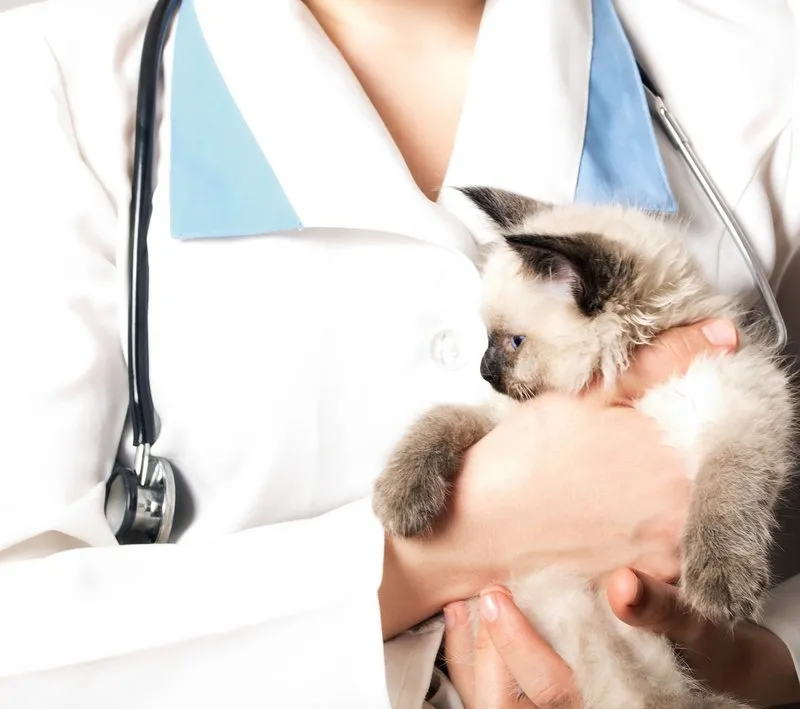Are you frequently enchanted by the sight of a super adorable kitten photo? Cats steal our hearts at every point in their journey, but it’s during their kittenhood that they become particularly lovable, not to mention incredibly entertaining. What is it about kittens that makes them so endearing? What unique qualities do these fluffy companions possess that leave us spellbound? Here are some entertaining facts about lovable little Fluffy from a West Greenwich, RI veterinarian!
The Purr-fect Sound
We’re all aware that cats purr, correct? This likely originated as a means of communication between mother and kitten. While nursing, little Fluffy can’t meow. Purring probably started as a way for both mother and kitten to convey their sense of safety, comfort, happiness, and love.
Biscuit Making
Cats, our adorable companions, display many endearing behaviors. Among them, Fluffy’s affectionate yet sometimes painful habit of kneading, or “making biscuits,” is noteworthy. This behavior originates from kittenhood, when kneading stimulated milk flow during nursing. Therefore, when your adult cat kneads, it indicates a strong bond, viewing you as a nurturing figure.
Newborn Kittens Sport Blue Eyes
Every kitten is born with blue eyes. Little Fluffy will not open her eyes until approximately a week after birth. When she does, the color of her eyes may start to change. By the time she reaches about a year old, her permanent eye color will have settled in. However, the pigmentation might still undergo changes for another year. Naturally, some cats, like the Siamese, retain their blue eyes.
Beginning with Blindness
The vulnerability of newborn kittens results from being born blind and deaf. Even after their eyes open, it takes roughly a month for their vision to fully develop.
Paw-sing Over Claw Capabilities
Ever experienced the sharpness of a kitten’s scratch? Whether Fluffy was frolicking around the house or trying to climb up your appendages, it likely left you wincing. Those little daggers pack quite a punch! Interestingly, a kitten’s claws tend to be sharper than those of adult cats, given their smaller size. Don’t worry though, after about 4 weeks, your little leopard should know how to retract her claws.
Felines Age at Individual Rates
It’s intriguing to learn that cat breeds don’t all mature at the same rate. Consider the Maine Coon, which typically doesn’t reach full maturity until around three or four years old. Additionally, there are some cats that retain their playful kitten-like qualities indefinitely, but that’s a story for another occasion.
Through the Ages, They’ve Continued to Charm Us
Cats and humans have been companions for about 10 to 12,000 years, according to research, with the relationship beginning during the early days of agriculture in the fertile crescent. Picture our ancestors from that era, utterly captivated by these fluffy companions! By the time ancient Egypt flourished, cats had firmly entrenched themselves in our affections. Egyptians revered cats, seeing them as sacred beings, with their reverence extending to a cat goddess named Bast, frequently depicted with lively kittens at her feet.
Folklore is Enriched by Their Adventures
Throughout various cultures, cats have been woven into the fabric of myths and legends, and one tale that highlights the charm of kittens is the legend of the pussy willow. In this enchanting story, tiny felines found themselves in a tricky situation, carried away by a river’s swift current. But fate smiled upon them as a kind-hearted tree standing by the water’s edge heard their cries and extended its branches, offering a lifeline to the stranded kittens. Since that fateful day, the tree has bloomed with buds adorned in soft down, a touching tribute to its furry little companions. It’s a heartwarming reminder of the enduring bond between cats and the natural world, wouldn’t you agree?
Can a Cat’s Litter Have Multiple Fathers?
According to a West Greenwich, RI vet, cats have the remarkable ability to produce litters with different fathers, although it’s not very common. This means that kittens in a litter may only be half-siblings genetically. It’s an interesting aspect of feline reproduction.
Kittens Are Reliant on External Warmth
It’s not until kittens are approximately five weeks old that they can regulate their body temperature. During their first month, they depend on their mother and littermates for warmth, making them vulnerable to cold temperatures.
Many cats, even as they age, never lose the inclination to seek out warm napping spots. For example, Fluffy loves to bask in the sunlight and cuddle up in warm laundry baskets. This behavior remains unchanged, offering them comfort and relaxation.
What Makes Them So Precious?
When it comes to kittens, words like cute, adorable, and charming are often used. But what exactly makes them so endearing? One possible reason is their relatively large eyes compared to their heads. It’s intriguing that while Fluffy’s head grows, her eyes remain unchanged. This unique trait adds to their appeal, making them even more adorable.
Yet again, little Fluffy’s playful antics and adorable vocalizations have a way of warming hearts.
Clowder or Kindle: What’s the Difference?
Were you aware that an assemblage of cats is technically termed a clowder? Likewise, a group of kittens has an official name: a kindle.
A Remarkable Rarity
On occasion, a special cat captures our hearts and becomes a sensation. In recent years, many internet-famous cats like Grumpy Cat and Colonel Meow have garnered attention. One notable example was Lil Bub, nicknamed the perpetual kitten due to her dwarfism, which hindered her tooth growth. Despite aging, she retained an adorable kitten-like appearance.
An Alternative Worldview
Fluffy and her feline counterparts have their own unique perspectives on life. Cats like Fluffy perceive the world differently from humans. They excel in depth perception and night vision, but their color perception is limited compared to ours.
Cat-tastic Contributions to Literature
The presence of kitty paw prints on medieval manuscripts serves as a reminder of the enduring bond between cats and humans. Throughout literary history, cats have played significant roles in stories. From Dinah in Alice in Wonderland to beloved characters like Hello Kitty and Nermal from Garfield, feline companions have left an indelible mark. Their inclusion in literature speaks to the timeless appeal of these mysterious creatures.
Are They Tiny Kittens or Cubs?
Within the world of big cats, intriguing parallels with our domestic feline companions emerge. These majestic creatures often display behaviors and preferences akin to those of our beloved housecats, including their fondness for snug boxes. Yet, amid these resemblances, significant differences come to light. Unlike their smaller counterparts, the offspring of large cats are commonly referred to as cubs, highlighting the distinctive aspects of their lifestyles and habitats.
Have You Ever Wondered About the Origin of “Kitten”?
Ever thought about why we call young cats kittens? The answer lies in Middle English, where “kitoun” originated from French “chitoun” or “cheton,” signifying a young cat.
Earthquake Detection: Is It Something They Can Do?
Is there a chance that cats possess sensitivity to the Earth’s magnetic fields and can detect tremors? While research continues, it’s a plausible theory. Cats’ capability to detect slight changes, such as wind direction, using their paw pads and whiskers, and sense impacts, like footprints, supports this idea.
Is Magic a Part of Their Nature?
Did you know that cats have a unique ability to purr at specific frequencies? It’s quite fascinating. Typically ranging between 25 and 140 Hertz, these vibrations have diverse applications. They’re not just soothing; they’re also used in physical therapy for tissue healing.
Are They Miniature Predators?
Cats, by nature, are hunters. While Fluffy may enjoy a life of luxury, her hunting instincts remain strong. Kittens, particularly, are fascinated by their claws and teeth. However, this exploration can be risky, highlighting the importance of pet-proofing. Cats’ hunting instincts endure, reflecting their wild ancestry even in domestic settings.
Our Advice on Intriguing Facts About Kitty Cats in 2024
How often should kittens visit the veterinarian for check-ups and vaccinations during their first year of life?
Kittens should visit the veterinarian for check-ups and vaccinations several times during their first year of life. Initial visits should occur at 6-8 weeks of age, followed by visits every 3-4 weeks until they are about 16 weeks old. These visits ensure they receive essential vaccinations against diseases such as feline distemper, calicivirus, and rabies. Additionally, the vet will check for parasites, monitor growth and development, and provide guidance on nutrition and care. Regular veterinary visits are crucial for establishing a strong foundation for a kitten’s long-term health and well-being.
What are some effective methods for litter box training kittens?
Effective methods for litter box training kittens include starting with a small, easily accessible box and placing it in a quiet, consistent location. Introduce the kitten to the box immediately after meals and naps, gently placing them inside. Use unscented, non-clumping litter to avoid overwhelming their sensitive noses. Clean the box regularly to encourage use and prevent aversion. Positive reinforcement, like gentle praise or treats, can help reinforce good habits. Avoid punishing accidents; instead, promptly place the kitten in the box to foster understanding. Consistency and patience are key to successful litter box training.
What are the benefits and drawbacks of keeping kittens indoors versus allowing them to roam outdoors?
Keeping kittens indoors offers significant benefits, including protection from predators, traffic, diseases, and harsh weather. Indoor kittens are less likely to encounter fleas, ticks, and infectious diseases like feline leukemia and FIV. Additionally, indoor living prevents the risks of getting lost or injured. However, drawbacks include potential boredom and lack of natural stimulation, which can be mitigated with interactive toys, climbing structures, and regular playtime. For a great compromise between indoor safety and outdoor enrichment, consider building a catio – you can learn more about these outdoor enclosures on National Catio Day. Allowing kittens to roam outdoors can provide mental stimulation and exercise but exposes them to various dangers. Balancing safety with enrichment ensures a healthy and happy indoor life.
How can owners introduce a new kitten to other pets in the household?
Introducing a new kitten to other pets requires a gradual and controlled approach. Start by keeping the kitten in a separate room, allowing the pets to get used to each other’s scents through closed doors. After a few days, conduct brief, supervised meetings, keeping interactions positive and calm. Use barriers like baby gates if necessary. Provide plenty of attention and reassurance to resident pets to prevent jealousy. Gradually increase the time they spend together, always monitoring for signs of aggression or stress. Patience and positive reinforcement are crucial for a smooth transition.
What are some engaging toys and activities that can help keep kittens mentally stimulated and physically active?
Engaging toys and activities for kittens include interactive toys like feather wands, laser pointers, and puzzle feeders, which stimulate their hunting instincts and mental acuity. Balls and small, lightweight toys that they can chase and bat around help keep them physically active. Climbing structures, such as cat trees and scratching posts, provide opportunities for exercise and exploration. Rotating toys regularly prevents boredom. Interactive play sessions with owners, using toys that mimic prey, can further enhance their physical and mental stimulation, fostering a healthy and happy environment for growing kittens.
Have inquiries about kitten care? Reach out to us, West Greenwich Animal Hospital in West Greenwich, RI, for assistance. We’re always happy to lend a helping hand! Don’t forget to schedule regular wellness check-ups and vaccinations to ensure your kitten grows into a healthy adult cat.




!Social Media Icons